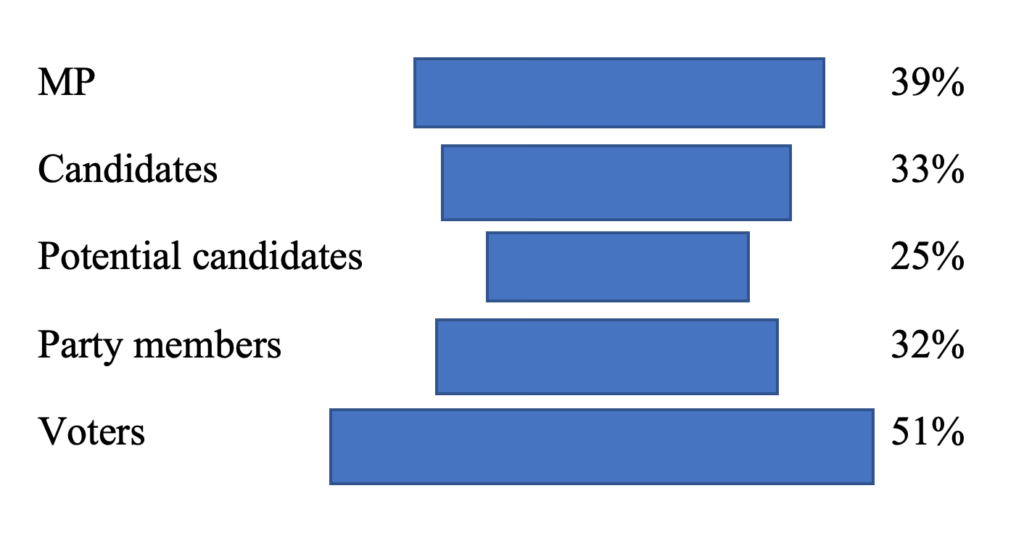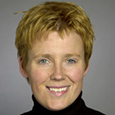The ‘hourglass’ pattern of representation: why political parties are key to electing more women to parliament
The underrepresentation of women in politics is often portrayed as a pyramid, with the main problem identified as too few at the top. However, research by Ulrik Kjær and Karina Kosiara-Pedersen, shows that, in the case of Denmark, it follows an hourglass pattern, with underrepresentation worst at the intermediary stages of party membership and candidate identification. This suggests that party strategies for encouraging women to stand are important for improving representation.
 Picture: Pixabay/Public Domain
Picture: Pixabay/Public Domain
Women’s descriptive underrepresentation in parliaments is traditionally presented as the result of a process that discards women as they move up the ladder of recruitment. The further up the recruitment process, the fewer women. The resulting pyramid shape of female representation points to the relevance of looking at each of the steps in the recruitment ladder to understand how women are sorted out along the way. And to see how the glass ceiling actually looks. However, recent research shows that voters do not punish women at the last step of the recruitment ladder. While women candidates in some countries and parties are less likely to get elected than male candidates, this is not the case across the board.
In our analyses of the case of Denmark, which is generally considered to be friendly to gender equality, we demonstrate an alternative hourglass pattern where women’s presence does decrease in the early phases of the political career ladder but increases in the later phases. Using data from party membership surveys conducted in 2000 and 2012, we can see there are fewer women among party members (32 percent; 2012 figures) than among party voters (51 percent), and fewer women among potential candidates (25 percent) than among party members. However, there is a higher share of women among nominated candidates (33 percent) than among potential candidates, and among elected MPs there are relatively more women (39 percent). As the results of the US midterm elections of 2018 so amply show, variation across parties is expected. This is only to some extent the case in Denmark, and the hourglass pattern is found for almost all the parties – now as well as for data from 2000. The share of women is smallest among the potential candidates, or the aspirants.
Figure 1: Women’s representation across different levels on the ladder of recruitment (the length of each bar equals the percentage of women in the group) in Denmark
Notes: Aggregate results for 2012
This leads us to the follow-up question, namely, whether the gender gap in recruitment potential is an effect of gender or of other factors. The relative decrease in women surviving this important phase in the recruitment process could be due to a distribution effect where women systematically possess fewer characteristics that are important in the recruitment game. In order to test whether the largest overrepresentation of men in the centre of the hourglass model is a gender effect, we test recruitment potential in an analysis with various control variables that have been shown to explain political recruitment: the sociodemographic variables of age, education and income, family obligations, elected office, party office, political interest and self-perceived political competence. Most of these ‘usual’ explanations for recruitment potential hold. More importantly for the hourglass model is that women are statistically significantly less likely to say that they would stand or consider standing for election if encouraged by their party when we have controlled for these usual explanations. Hence, the gender gap is not due to a distribution effect where women systematically possess fewer of these characteristics. This result is again consistent at the aggregate and party levels in both 2000 and 2012.
The obvious implication of this finding is that the traditional pyramidal pattern cannot be taken for granted. However, more importantly, the observation of an hourglass pattern in Denmark should lead to more comparative research on the gendered ladder of recruitment. Advocates of gender equality should be able to target their endeavours to ensure more women are elected to parliament to the phases of the recruitment process that are most important in the specific context. In countries with an hourglass pattern, such as Denmark, the implication of the finding is that advocates for gender equality should focus on membership recruitment by political parties and on internal party processes that aim to develop party members’ willingness to run for political office prior to the formal nomination process. As others before us have pointed out, political parties are central to candidate recruitment – they are key actors when it comes to getting more women to become party members and more female party members to develop a taste for political office.
This post represents the views of the authors and not those of Democratic Audit.
It draws on the authors’ article, ‘The hourglass pattern of women’s representation’, forthcoming in the journal Journal of Elections, Public Opinion and Parties.
About the authors
 Ulrik Kjær is Professor of Political Science at the University of Southern Denmark.
Ulrik Kjær is Professor of Political Science at the University of Southern Denmark.
 Karina Kosiara-Pedersen is Associate Professor of Political Science at the University of Copenhagen.
Karina Kosiara-Pedersen is Associate Professor of Political Science at the University of Copenhagen.





 Democratic Audit's core funding is provided by the Joseph Rowntree Charitable Trust. Additional funding is provided by the London School of Economics.
Democratic Audit's core funding is provided by the Joseph Rowntree Charitable Trust. Additional funding is provided by the London School of Economics.